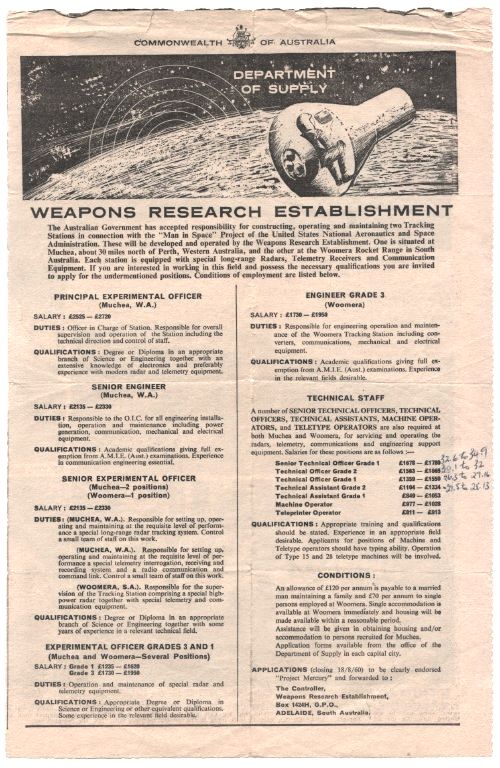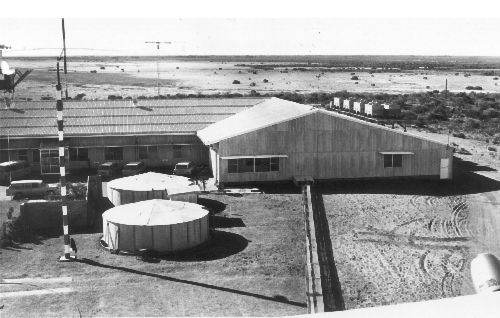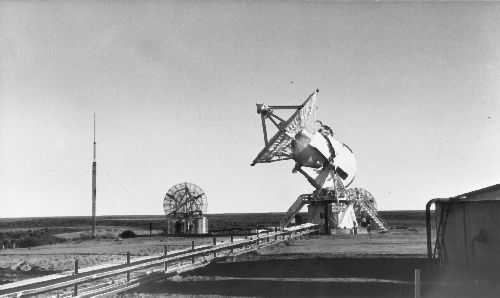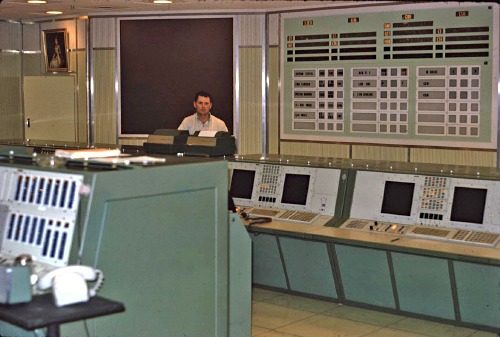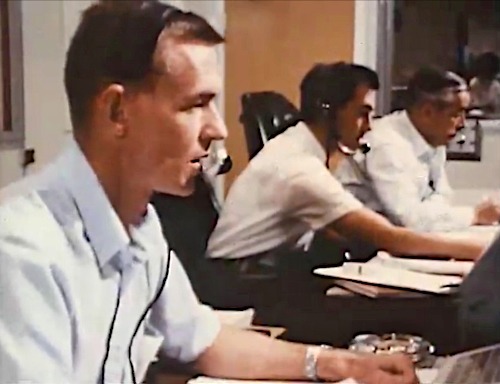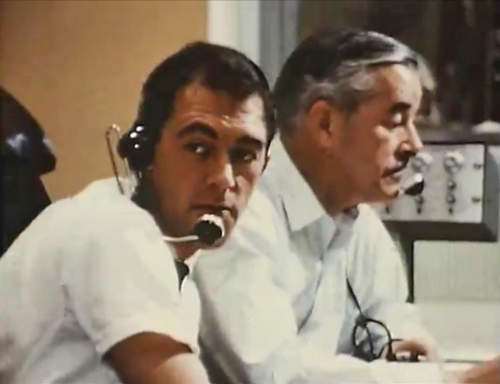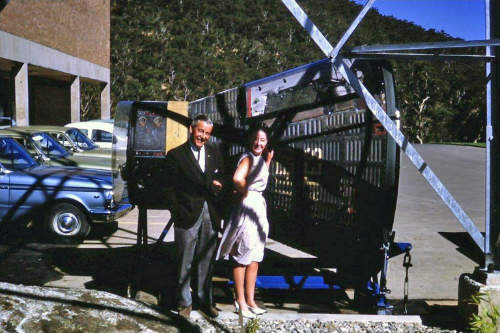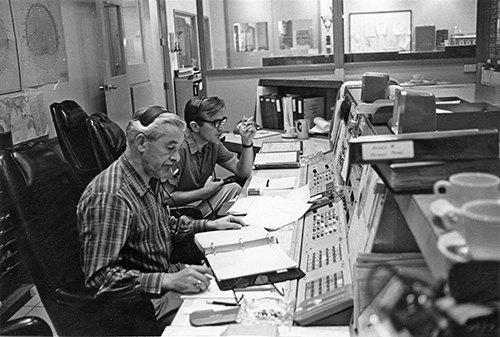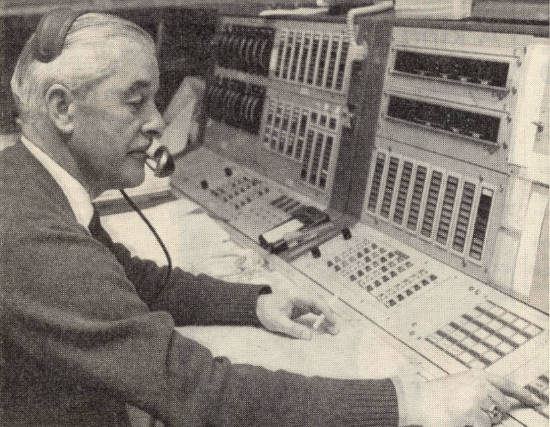Ken Lee, “The Silver Fox”, at Honeysuckle Creek in August 1967.
Polaroid ID photo by Hamish Lindsay. Preserved by Bryan Sullivan.
Scan and image repair by Colin Mackellar.
Ken Lee
1923 – 1990
Muchea, Darwin, Honeysuckle Creek
What follows is an attempt to piece together something of Ken’s life and career. This is gleaned from recollections of Jack Duperouzel (Muchea), Gordon McDonald (Muchea and Cooby Creek) and John Saxon (Honeysuckle Creek and Tidbinbilla) with additional information and guesswork by Colin Mackellar, so please bear in mind that it may not all be accurate! |
Ken Lee, “The Silver Fox”, at Honeysuckle Creek in August 1967. Polaroid ID photo by Hamish Lindsay. Preserved by Bryan Sullivan. |
Ken Lee served as one of the two Operations Supervisors at Honeysuckle Creek from the station’s beginning until he moved on in mid-1970. By the time he came to Honeysuckle, he was one of the more experienced space trackers in Australia, though he shared little of his story with colleagues at Honeysuckle.
Early years
Kenneth Simpson Lee was born in Leeds in Yorkshire in 1923.
A Kenneth S. Lee – whose mother’s maiden name was Simpson – was born in Leeds in 1923. In 1939, he was working as an Invoice Clerk for a soap manufacturer. This is very likely to have been Honeysuckle’s Ken Lee who was 66 when he died in 1990. (1,7)
World War II and aftermath
Towards the end of World War II Ken served with the Fleet Air Arm of the Royal Navy’s Pacific Fleet as a Petty Officer, Radio / Radar Mechanic. (2) Ken “was a radar man [in the Royal Navy] from way back”. (3)
In 1946, Ken arrived in Sydney (possibly on the Light Fleet Aircraft Carrier HMS Glory), having been involved with expatriating Indian Prisoners of the Japanese from Singapore back to India.
While in Australia he was stationed at Nowra, NSW, Jack Duperouzel thought Ken had possibly also spent some time at the airfields at Schofields and Bankstown in Sydney.
On his return to the UK, Ken married Elizabeth, a WREN (a member of the Women’s Royal Naval Service). (2)
Australia, England, Canada and Australia again
In 1949, Ken and Elizabeth emigrated to Australia (4) where Ken worked for some time with the Weapons Research Establishment (WRE) at Elizabeth, South Australia. (2)
After returning to the UK, Ken and his wife travelled to Canada where he worked on the DEW line. (2, 3) The Distant Early Warning Line was the first line of radar defense in the far north of Canada – designed to detect Soviet long-range bombers before they could deliver nuclear bombs to targets in the USA.
The DEW Line is the northernmost Radar Defence Line. |
It was while he was involved in this radar work in Canada, Ken heard about the establishment of tracking stations in Australia to support Project Mercury. He applied to the WRE, and was accepted to run the VERLORT Radar which would be established at Muchea in Western Australia. (2)
A newspaper advertisement for jobs at Muchea and Woomera (Red Lake). At Muchea, two Senior Experimental Officers are wanted for Radar: “Responsible for setting up, operating and maintaining at the requisite level of performance a special long-range radar tracking system. Control a small team of staff on this work.” Preserved by Jack Duperouzel. Scan by Colin Mackellar. |
Muchea
Having been accepted (his previous work with WRE would have been an advantage), Ken was sent to Point Mugu in California for training on the VERLORT (VERy LOng Range Tracking) Radar. Since 1946, Point Mugu was the home of the Pacific Missile Range. The VERLORT Radar was an extended version of the highly successful WWII-era SCR-584 fire-control radar.
The VERLORT tower and trailer at Muchea, late 1961. Frame grab by Colin Mackellar from NASA film. |
Ken was on the team at Muchea from the very start. Jack Duperouzel remembered that he, Ken Lee (in charge of the VERLORT Radar) and Jack Walker (Engineer in charge of the Acquisition Aid) were the first three permanent staff to arrive at Muchea in November 1960, as equipment was still being installed. (2)
Ken was at in charge of the VERLORT Radar at Muchea all the way through the Mercury Program.
During a Mercury pass, the Acquisition Aid would first locate the spacecraft, and pass the azimuth and elevation data to the VERLORT radar which would then lock on to the spacecraft. The voice and telemetry antennae would slave to the radar for the rest of the pass.
Ken Lee (right) and Don Blackman in the VERLORT van at Muchea, late 1961. Frame grab by Colin Mackellar from NASA film. |
Darwin
At the end of Mercury, as operations at Muchea wound down, in late 1963 or 1964, Ken led the small WRE team which went to Darwin to man the Project ANNA transportable station in support of the ANNA Geodetic satellite program. (2,3)
The Project ANNA telemetry van was first shipped to Muchea, presumably for training, before it was taken to Darwin.
What seems to be the ANNA team – or related personnel – with the ANNA telemetry van from the Pacific Missile Range – at Muchea. Team leader Ken Lee is on the right at the back. Photo: Ronald Sparks. Scan: Teresa Sparks. |
The Project ANNA station seems to have been treated as an annex of the Carnarvon Tracking Station (as the OGO Darwin station was).
The Project ANNA team at Darwin, probably 1964. Third from left – Ken Lee (ex-Muchea) From the Tidbinbilla archives – scan by Colin Mackellar. |
Team leader Ken Lee at the door of the ANNA van. |
The ANNA Telemetry van, adjacent to Emery Point Lighthouse, Larrakeyah Barracks, Darwin. From the Tidbinbilla archives. Scan by Colin Mackellar. |
Training at Carnarvon, May 1966
It’s not clear exactly when the ANNA support at Darwin ended, or what Ken was doing in 1965, but by May 1966, he was involved in preparation to become an Operations Supervisor at Honeysuckle Creek.
In May 1966, the Honeysuckle Creek Operations Building and the Powerhouse building were largely complete, though the equipment was still to be installed. Work on the construction of the 85-foot (26-metre) antenna was beginning.
Ken took a roll of black and white film (a 35mm roll of 36 exposures) covering several weeks in May 1966. (5) The first few frames and the last few frames were taken at Honeysuckle Creek and in suburban Canberra. The central part of the roll was exposed in Carnarvon. It seems that he was sent to Carnarvon to gain some hands-on experience with Apollo Unified S-Band tracking equipment and procedures.
As Ken was leaving for Carnarvon, the Honeysuckle antenna was in the early stages of assembly. Photo: Ken Lee. 35mm scan: Colin Mackellar. |
By May 1966, only four more Gemini flights remained, and Carnarvon was already gearing up to support Apollo, using the purpose-built Apollo Equipment extension to the main T&C Building and the recently-completed 9 metre USB antenna.
The Carnarvon Apollo T & C Extension (on the right) as seen from the 9 metre USB Antenna, 03 May 1966. Department of Supply (?) photo via Trevor Mosel and Stuart Wattison.
|
The Carnarvon Apollo 9 metre USB Antenna, as seen from the Servo window, 03 May 1966. Photo via Trevor Mosel and Stuart Wattison. |
The Carnarvon Apollo consoles included positions similar to those used for Gemini – including a Capcom. By the time Honeysuckle Creek and the other 26-metre Apollo stations were completed, communications between the remote sites and Houston had improved to such an extent that these remote consoles were deemed unnnecessary. (6)
John Lambie stands in the Apollo Control Room at Carnarvon, June 1967. Transparency: John Lambie. Scan by Colin Mackellar. |
While Ken was at Carnarvon, the Apollo Network Simulation 2 (NS2) took place. Chuck Lewis, who has been Capcom at Carnarvon for Gemini V the previous year was back for the network-wide simulation. It seems that Ken was co-opted to sit on the Apollo console with Chuck Lewis and Carnarvon’s Terry Kierans for a segment filmed for a NASA movie on the tracking networks.
This frame from the film The Vital Link (from 18:45) apparently filmed during Network Simulation 2 in May 1966. Closest to camera, Chuck Lewis is sitting at the Apollo M&O console. Ken Lee is at the far Apollo console position. Carnarvon’s Terry Kierans is between them. Footage with thanks to Dick Nafzger. Frame grabs by Colin Mackellar. |
Terry Kierans and Ken Lee at the new Apollo console at Carnarvon. |
Ken Lee took this photo of the console where he was positioned for the film. 35mm scan: Colin Mackellar. |
Honeysuckle Creek
Back at Honeysuckle Creek, Ken captured this image of the turret for the 26-metre antenna being assembled. 35mm scan: Colin Mackellar. |
In September 1966, Ken and John Saxon travelled to the Network Training and Test Facility at the Goddard Space Flight Center in Greenbelt, Maryland.
The Network Test and Training Facility – Building 25 at the Goddard Space Flight Center, Greenbelt, Maryland. The NTTF was the centralised training location for selected members of the Manned Space Flight Network (MSFN) and the Spacecraft Tracking and Data Acquisition Network (STADAN). |
John Saxon recalls a story from the trip at 29'26" in this 2017 video interview. |
Honeysuckle Opening Day
On Honeysuckle’s Opening Day – 17th March 1967 – Ken joined John Saxon in demonstrating features of the Operations Console.
Ken holds Prime Minister Harold Holt’s headset in place as he speaks with US Vice President Hubert Humphrey at the Ops Console. From left to right: Edmond Buckley Associate Administrator for Tracking and Data Acquisition; Photo by Ron Hicks. |
After the opening ceremony and luncheon, the Lees chat with the Westbrooks in the marquee erected nxt to the Operations Building. L-R: (Standing) Ken Lee, Kevyn Westbrook. (Seated) Joan Westbrook, Liz Lee. Kevyn Westbrook was in charge of Ground Communications at Muchea when Ken was running the radar. Wes Moon is walking past, on the right. The Gemini X capsule is in the background. Transparency: Martin Geasley. Scan: Bec Bigg-Wither. |
Around the time of opening day, Jack Duperouzel and his wife Jenny caught up with Ken at Honeysuckle Creek while on a visit from Perth.
Ken Lee and Jenny Duperouzel stand with the Gemini X capsule which was on display for the Honeysuckle opening. Photo: Jack Duperouzel. |
Honeysuckle Creek Apollo Operations
 |
A very early photo of John Saxon and Ken Lee at the Honeysuckle Operations Console. Probably late 1966. Photo by Hamish Lindsay. Medium format negative scan: Colin Mackellar. |
Around 3:00am on Christmas Day 1968, as Apollo 8 orbits the Moon, Operations Supervisor Ken Lee and Station Director Tom Reid man the Honeysuckle Creek Operations Console. By this time, the Ops Console has become a little less tidy! Photo by Don Witten, Public Information Officer visiting from the Goddard Space Flight Center. Photo preserved by Hamish Lindsay. Scan by Colin Mackellar. |
Ken Lee in the right-hand seat at the Honeysuckle Creek Ops Console just before Apollo 11. Published in the Australian Department of Immigration’s The Good Neighbour magazine, No. 187, August 1969. (Colourised and enhanced version with thanks to Glen Nagle.) |
Ken Lee’s entries in the Honeysuckle log for the countdown and launch of Apollo 11, 16 July 1969. Liftoff is at 1332 GMT. |
Ken Lee is pictured in this post-Apollo 11 photo showing most of the Honeysuckle team. |
Ken was Operations Supervisor at Honeysuckle Creek from 1966 until after Apollo 13.
It’s not known why he decided to move on from Honeysuckle, but perhaps the anticipated hold on Apollo missions after the Apollo 13 near-disaster was a factor.
It’s also not clear if he was at the station for the Apollo 13 mission. Perhaps he was on Long Service Leave. Whether that is the case or not, the photo below seems to show Ken receiving a farewell gift from Station Director Don Gray. The Pan American Airways calandar on the wall is for July 1970.
Operations Supervisor Ken Lee is farewelled by Station Director Don Gray and his opposite number, John Saxon, in July 1970. Ken has apparently been presented with a pen(?), card, engraved mug, and badge. Photo almost certainly by Hamish Lindsay. |
After Honeysuckle Creek
Jack Duperouzel remembered that Ken and Elizabeth had two children. After Honeysuckle Creek, the Lees returned to Canada, though one of their children remained in Australia.
Jack kept in touch with Ken, and visited him in Toronto, some time in the 1980s.
Ken died in Toronto on 9th June 1990 at the young age of 66. (7) He is remembered for his humour, and for his wide experience in the early days of radar and in the first steps to landing men on the Moon.
If you are able to correct any of this information, or add more, I would be very grateful to hear from you. – Colin Mackellar. |
Sources:
1. Mike Dinn search of U.K. birth and census records.
2. Memories of Jack Duperouzel (Muchea).
3. Memories of Gordon McDonald (Darwin, Orroral Valley, Cooby Creek) – e-mail February 2011.
4. Note in the Australian Department of Immigration’s The Good Neighbour magazine, No. 187, August 1969.
5. Before he left Honeysuckle, Ken gave his negatives to Hamish Lindsay. Hamish passed these on to Colin Mackellar in 2021.
6. Personal correspondence from Carnarvon’s Paul Dench.
7. Death notice in The Canberra Times, 16 June 1990, page 27. (Scan on Trove.)


